|
LIRR M9s
|
|
PRODUCTION
|
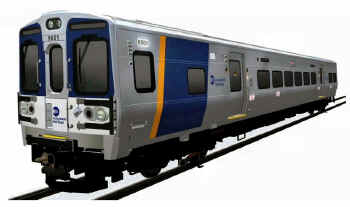
MTA/LIRR M9 #9001 10/2017
|

LIRR #9001 Kawasaki Heavy
Industries -
Hyogo Works, Japan 2016
|
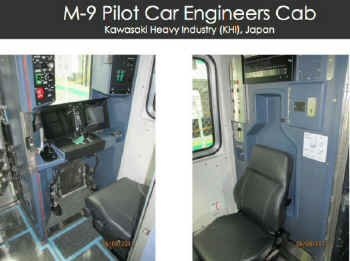
M9 Engineer Cab 2016
|
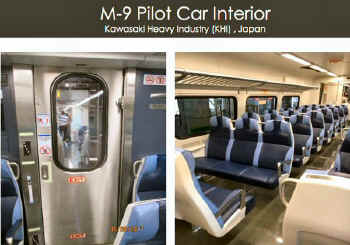
M9 Pilot Car Interior Cab forward
2016
|

M9 Pilot Car Interior - Rear view
2016
|
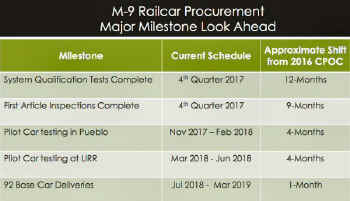
M9 Procurement Milestones Look
Ahead
This section: Photos/Resource: MTA/LIRR
|
|
|
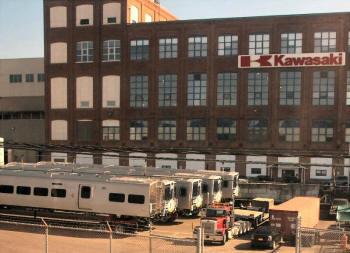
Kawasaki Plant, Yonkers - M9 #9064, 9063, 9057, 9058, 9055
10/15/2019 Photo/Archive: Tim Darnell |
|
|
INITIAL DELIVERY
|
|
On Sunday, April 29, 2018, M9s 9010-9009 and
9014-9011 were transferred from the New York & Atlantic Railway Co. Fresh Pond Yard to the LIRR for acceptance and testing. These cars are part of an initial order of 92 cars from Kawasaki, with options for 508 more. The recently repainted
LIRR MP15AC # 154, will lead toward Jamaica.
Marc Glucksman
|
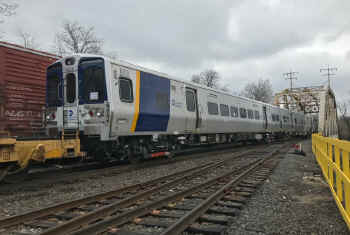
M9s delivery to Fremont Jct. view N 4/29/18 Photo: Barry Johnson
|

NYA delivery to Fresh Pond view W 4/29/18 Photo: Barry Johnson
|
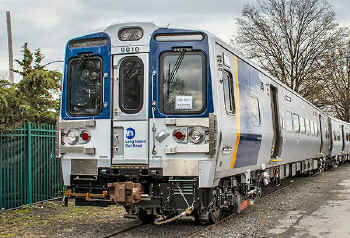
M9 #9010 Fresh Pond 4/29/18
Photo: Greg Grice
|

Kawasaki M9s transfer from Fresh Pond 4/29/18
Photo: Marc Glucksman
|
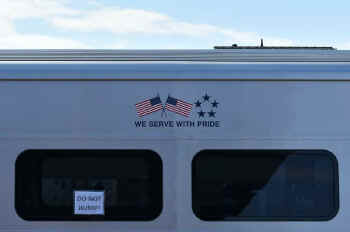
Kawasaki M9 Window detail 4/29/18
Photo: Paul Pesante
|
|
|
MOVED TO HILLSIDE
|
|
,
|
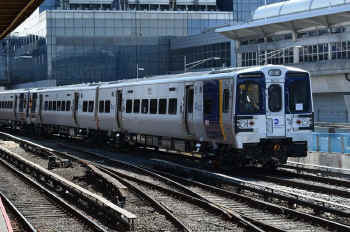
Kawasaki M9s Jamaica 4/29/18 Photo: Paul Pesante
|
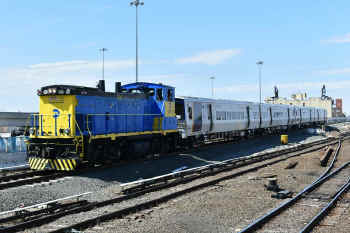
LIRR MP15AC #154 - Kawasaki-M-9s Jamaica 4/29/18
Photo: Paul Pesante
|
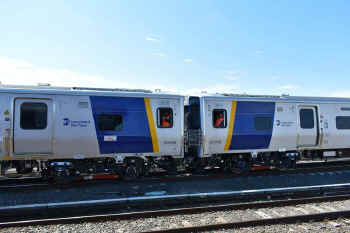
Kawasaki M9s 9009/9014 at Jamaica 4/29/18 Photo: Paul Pesante
|
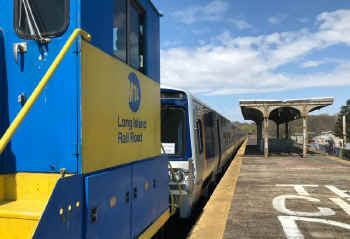
MP15AC #154 M-9s arrive at Hillside Station 4/29/18
Photo: Barry Johnson
|
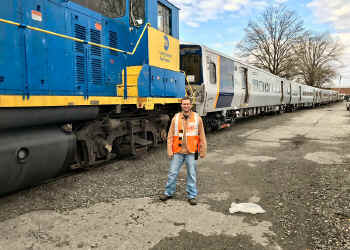
MP15AC #154 M-9s at Hillside Station 4/29/18
Photo: Barry Johnson, Road Foreman of Engines
|

M9s stored at Hillside "Boneyard" 4/29/18
Photo: Barry Johnson
|
|
|
M9 TEST TRAIN
|
|

|
|
"Nines at Republic" Long Island Rail Road & Kawasaki Heavy Industry's M9 Test Train head west past the former Republic Station on LIRR Main
Line, 3/11/2019. The six car train is making several runs throughout the LIRR system, testing each function the railcars have to offer. Republic station, which opened in 1940, served Republic Airport and employees of Fairchild Aircraft manufacturing company until
Republic Station was closed in 1986 as new stations with high-level
platforms opened as part of the Hicksville-Ronkonkoma
Electrification replacing low-level platform facilities. All that remains are the staircases that lead passengers from
NY Route 110 to the platform which are seen in the foreground and background of this photo.
Photo/Archive/Info: Greg Grice
|

M9 #9010 test train New Hyde Park 3/15/2019
Photo/Archive: Alex Vasic
|
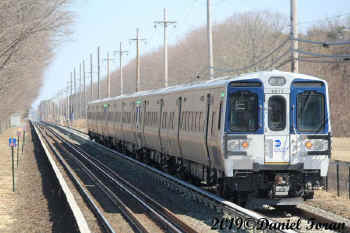
M9 #9011 test train Pinelawn 3/12/2019
Photo/Archive: Daniel Foran
|
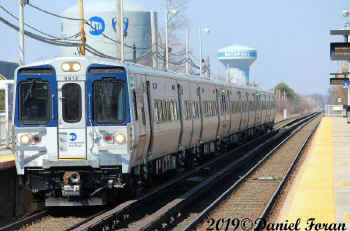
M9 #9012 Bethpage 3/21/2019
Photo/Archive: Daniel Foran
|
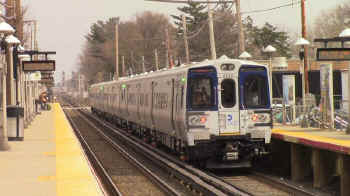
M9 #9013 test train New Hyde Park Station
3/15/2019 Photo/Archive: Alex Vasic
|

M9 #9013 test train Amityville 3/08/2019
Photo/Archive: Daniel Foran
|
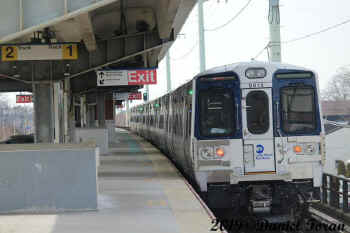
M9 #9014 test train Amityville Station 3/08/2019
Photo/Archive: Daniel Foran
|
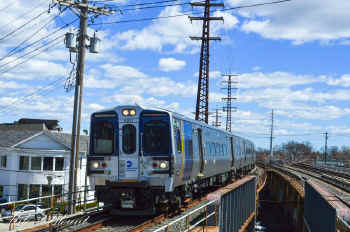
M9 #9011 test train Lynbrook 4/10/2019
Photo/Archive: Miles Blount
|
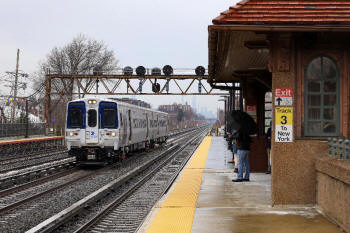
M9 #9183-9184 eastbound test run passing Forest Hills Station
1/23/2024 Photo/Archive: Thomas Farmer |
|
|
PRODUCTION ARRIVALS AT FRESH POND
|
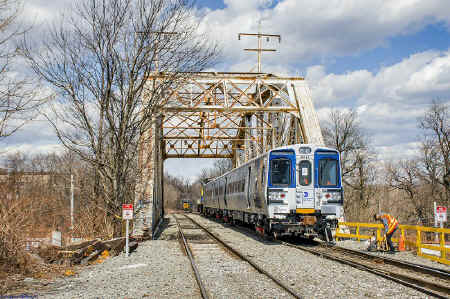
M9s #9015 and #9016 at Fresh Pond Interchange - View N 3/19/2019
Photo/Archive: Greg Grice
|
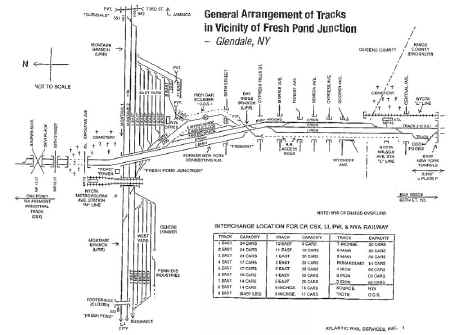
Fresh Pond map - NYA
|
|
Long Island Rail Road's Roustabout crew tow a pair of Kawasaki M9 EMUs over the Fresh Pond Bridge clear of the "Interchange" switch in order to get downstairs to the Fresh Pond Yard Wye. This pair, numbered 9015 & 9016, are the first "production" cars produced from Kawasaki's Lincoln Nebraska Plant. Once the pair is downstairs, Kawasaki officials inspect the cars for any damage that may have occurred in
transit. Greg Grice Note: They are shipped with regular AAR
couplers.
|
|
The horn as most have noticed is no longer the classic Leslie RS-2M. Leslie's prices have skyrocketed as of late, so the railroad has opted to use Nathan Airchime horns instead. The horns on the M9s are a Nathan K2H horn with K bells 2 and 3B. Additionally, it sounds like a single diaphragm is being used in the 2 bell instead of the standard double diaphragm, which is why the pitch changes on the 2 bell as the airflow from the valve increases. I will attempt to recreate this horn, as I have the K2H manifold, a raised letter 2 bell, and will soon possess a raised letter 3B bell (modified from a 3 bell). Stay tuned! Fan Railer |
|
PRODUCTION TEST TRAINS
|
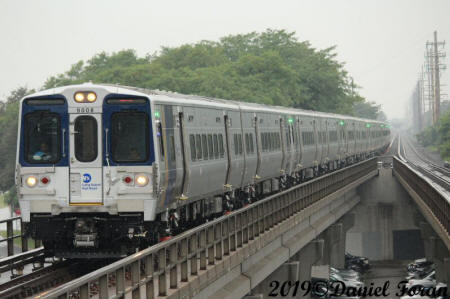
M9 #9008 eastbound approaching Bellmore 8/13/2019
Photo/Archive: Daniel Foran
|

M9 #9017 Bellmore Station 8/13/2019 Photo/Archive: Daniel
Foran |

CSX AC4400CW 475 leads Y102 with a Kawasaki (LIRR) M9 pair in tow
past Borax Paper Products on the Oak Point Link in the Bronx. The
pair (KRMX 9021/9022) has finished receiving modifications at
Kawasaki's plant in Yonkers and is on it's way to Fresh Pond Yard in
Queens for
pick-up by Long Island Rail Road. 8/26/2019
Photo/Archive/Info: Gregory Grice |

M9 #9015 press run westbound at Mineola 9/10/2019 |
|
FIRST RUN |
LIRR to Introduce New Fleet of
Rail Cars Tomorrow
M9 Cars to Enter Passenger Service as the 6:50
a.m. Train from Huntington on September 11, 2019:
Long Island Rail Road President Phil Eng
today announced that the LIRR’s next fleet of rail cars,
known as the “M9” cars, will enter into passenger service
tomorrow, Wednesday, Sept. 11, 2019.
The new cars incorporate and improve upon the most
successful and popular features of the MTA’s two recent
electric car fleets, the LIRR’s familiar M7s electric
cars, and the M8 cars serving Metro-North’s New Haven
Line, and will enhance safety.
“These new cars will offer new amenities
and a better environment for our customers,” Eng said.
“Even if your train isn’t composed of these cars, there’s
a good chance they will benefit you because as we receive
more of them, we will lengthen many of our busiest trains,
providing more seats for more customers.”
The fleet will consist of 202 cars, the
last of which are expected to begin passenger service in
March 2021. The first eight cars are entering service
tomorrow as the 6:50 a.m. train from Huntington, due into
Hunterspoint Avenue at 7:49 a.m. The trainset’s later runs
for tomorrow are anticipated to be as the 5:06 p.m. train
from Penn Station due into Hempstead at 5:57 p.m., and the
10:37 p.m. train from Penn Station, due into Babylon at
11:32 p.m.
The M9 trainset is expected to operate on
these same runs on Thursday. On Friday, the LIRR expects
to lengthen the trainset to 10 cars and operate it on a
different set of trains. The trainset will be lengthened
again by two more cars, on Sept. 20, with the resulting
12-car trainset serving yet a different collection of
trains throughout the days that follow.
The cars will have exterior destination
signs on the front of cars that are visible to passengers
as the train approaches the station, similar to the new
cars on Metro-North’s New Haven Line. They will have
electrical outlets on both sides of the car in each row of
seats, and closed loop armrests that won’t tear garments
or catch bag straps.
The cars will feature an innovation that
is new for the first time in the region: an electronic
display that will let passengers know what car within the
train they are seated (for example, “Car 3 of 10”) which
will be of help to customers exiting at stations where not
every car will meet the platform.
Walking from car to car will become easier
because between every other car there will be a door that
operates at the push of a button. The seats in the cars
will be slightly wider than the seats on the M7 cars, and
the cars will seat more people than the M7 cars, with up
to 6 additional seats in each pair of cars.
The cars are fully equipped for Positive
Train Control, a major safety enhancement that will reduce
the potential for human error to contribute to
train-to-train collisions or derailments. They have
cameras in the train engineer’s cab, facing into the cab
to monitor the engineer’s alertness and facing forward to
show the tracks ahead, and cameras in passenger area of
the cars to serve as a deterrent to criminal activity.
The bathroom experience will be enhanced
on the new cars, which will have better restroom design
that improves cleanliness. There will be no touch needed
for flushing the toilet, dispensing sink water and hand
soap and drying hands. There are improved restroom doors
and coat hooks and additional air quality treatments.
The cars will have additional speakers in
the vestibule for clearer public announcements, threshold
illuminating lights at the side and end doors, and are
anticipated to offer a smoother ride than the M7 cars and
reduce sun glare with a slightly increased level of window
tint.
The cars are being designed and
manufactured by Kawasaki Rail Car, based in Yonkers. The
first 14 pilot cars were built in Japan, with these first
eight aggressively tested in Pueblo, Colorado, before
further aggressive testing on the tracks of the Long
Island Rail Road. The remaining 188 cars are being
manufactured in Lincoln, Nebraska, with final assembly
taking place in Yonkers. 9/10/2019 MTA/LIRR
|
|
The LIRR's new M9 cars will include several
amenities, including:
Electrical outlets at every row of seats
Automatic pocket doors in between train cars that open with the
press of a button
A digital display on the exterior of the front car of the train
telling passengers waiting on platforms the train's destination
“No-touch” hand dryers, toilets, soap dispensers and faucets in
bathrooms
Increased window tint to reduce sun glare
Four 32-inch multimedia screens in each car
Closed-loop seat armrests that are less likely to snag and rip
clothes than on the M7 trains Source: LIRR
|

M9 Seating Chart |
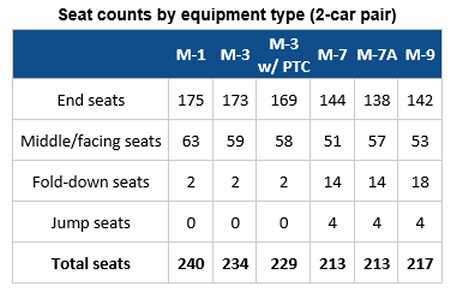
Source: thelirrtoday.com |
The inaugural revenue service for the M9s occurred this morning as
#9015 led Train #1621 from Huntington 6:50AM to Hunterspoint
Avenue 7:48AM, September 11, 2019.
The consist was: 9015-9016-9007-9008-9005-9006-9001-9002. Train#1621
stops: Huntington, Cold Spring Harbor, Syosset, Hicksville, Jamaica
and Hunterspoint Avenue. |
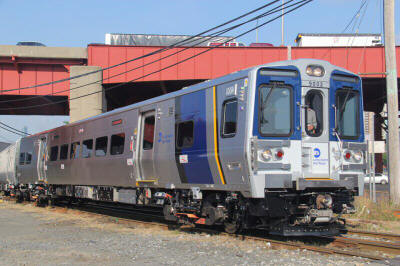
M9 #9002 first run LI City 9/11/2019 Photo/Archive: Jose Garrido
Alonzo |

M9 #9002 first run Hempstead 9/11/2019 Photo/Archive: Michael Kam |

M9 #9015 first run Syosset 9/11/2019 Photo/Archive: Bill Mangahas |

M9 interior first run 9/11/2019 Photo/Archive: Ed McMahon |
|
M9 PHOTOS |
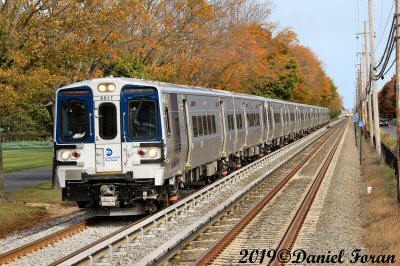
M9 #9017 Train #2055 Pinelawn - View E 10/10/2019
Photo/Archive: Daniel Foran |

M9 Wreck Lead bascule bridge - View N 10/25/2019 Source: MTA |

M9 #9017 Train #2041 Pinelawn - View E 12/06/2019
Photo/Archive: Neil Feldman |

M9 #9022 cab end view 1/27/2020 Photo: John Terry |

M9 #9040 Huntington west of Oakwood Rd. - View SW 8/27/2020
Photo/Archive: Jeff Erlitz
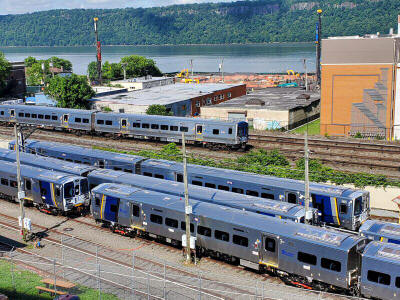
M9s at Yonkers for delivery to the LIRR.
Metro-North in background 6/17/2021 Photo: Jim William |

M9 cab 2021 Photo/Archive: Eli Hanson |

M9 door at Grand Central Madison - 8/09/2023
Photo/Archive: Tyrell Callender
|

M9 roof details 4/20/2025 Photos/Archive: J. Dooley
Photography
 |
Report finds Long Island Rail Road
shares blame for delivery problems with new railcars
|
|
NEW
YORK — An initial order for new electric multiple-unit railcars for
the Long Island Rail Road fell almost three years behind schedule
and more than $8.9 million over budget — and the commuter railroad
failed to collect damages and accepted cars with defects that were
not repaired in a timely fashion, according to a state audit report.
In a
response, the LIRR said it “fundamentally disagrees with the audit
conclusions.”
The
report from the office of New York State Comptroller Thomas DiNapoli
examines the acquisition of M9 EMU railcars from Kawasaki from the
time the order was placed in September 2013 to the point until
November 2020, by which time 64 of the 92 cars in the original order
had been conditionally accepted. The LIRR also exercised an option
for 110 additional cars in July 2017.
According to the report, LIRR officials say the M9 project is behind
schedule because of an accident in delivering eight pilot cars, and
because of testing at the Federal Railroad Administration test
center in Pueblo, Colo. The audit found that issues discovered
during the testing in Pueblo were not corrected before additional
cars were delivered with the same problems.
Cars accepted with defects which have not been fixed
The
report also says the LIRR contributed to the problem by accepting
cars with deficiencies under a “conditional acceptance” process in
the contract, It says the commuter railroad identified manufacturing
issues including inadequate employee training at the company’s
Nebraska factory, ineffective inspections prior to delivery, and
inadequate staffing at the final assembly facility in Yonkers, N.Y.
While the LIRR said it outlined corrective action, the report found
these actions were not effective.
As
of Aug. 13, 2020, the LIRR had accepted 62 railcars with a total of
9,230 defects or deficiencies — none of which are safety-related,
the railroad says. Over a year later, those defects had not been
corrected, nor had the LIRR set a deadline for the builder to do so.
With the contract running almost three years behind schedule, the
LIRR is focused on delivery of the remaining cars, not fixing
defects on those delivered. “The continued operation of railcars
with minor defects and deficiencies runs the risk of aggravating the
defects over time into conditions that will impact the operations of
the railcars and result in increased repair costs,” the report says.
Report says millions
in damages have not been assessed
The
contract with Kawasaki provides for liquidated damages; a subsequent
contract revision set damages at a flat rate per car, per calendar
day of delay, beginning 30 days after the a date set for each car in
the contract, until its acceptance or conditional acceptance. Under
the original contract, these damages were almost $12.9 million as of
January 30, 2019, but the revised contract waved those damages and
required the LIRR to pay $18.8 million to resolve outstanding
claims. Under the revised contract, the LIRR was in position to
assess $5.5 million in damages as of Sept. 11, 2020, a number
expected to reach $12 million for the first 92 cars. The LIRR said
its practice is to access damages at the end of a contract; the
audit contends the LIRR should act earlier “to prod the contractor
to improve its performance.”
The
report also found the LIRR had not ensured software testing had been
performed as required, and that it did not follow contractor
evaluation guidelines. It outlines a total of 12 recommendations to
address the issues identified by the audit.
LIRR response takes
issue with most points
The
response from LIRR President Phillip Eng says the commuter railroad
“strongly disagrees that it contributed to the delays by accepting
cars with deficiencies,” saying this is an industry practice with
non-safety related minor defects, and that it assists in expediting
the delivery schedule. It also says that contrary to the audit
report, its remedial actions with the manufacturing problems were
effective.
While the audit claims there are $8.9 million on overruns, the LIRR
contends no overruns exist because the contract combines both the
phases of the contract instead of breaking out the initial order, as
was done in the audit. It also says it is inaccurate that the LIRR
did not assess damages, as those damagers were part of a negotiated
settlement.
On
the matter of unaddressed defects, the LIRR says that because cars
must be taken out of service to be modified, “it is to LIRR’s
benefit to combine as many modifications as possible so the cars
come out of service as few times as possible.” It also says the
report “dramatically overstates” the significance of operating cars
with minor defects. 3/29/2022 Trains.com |
|
|
|
|
|
|
|
|